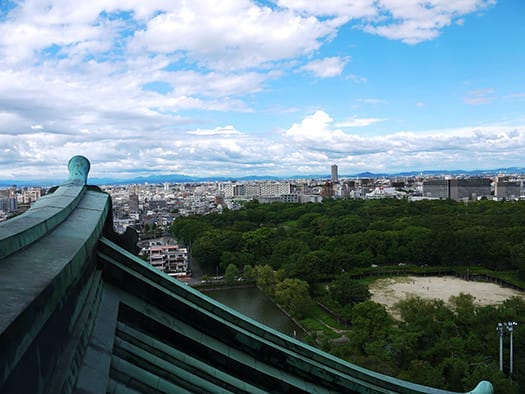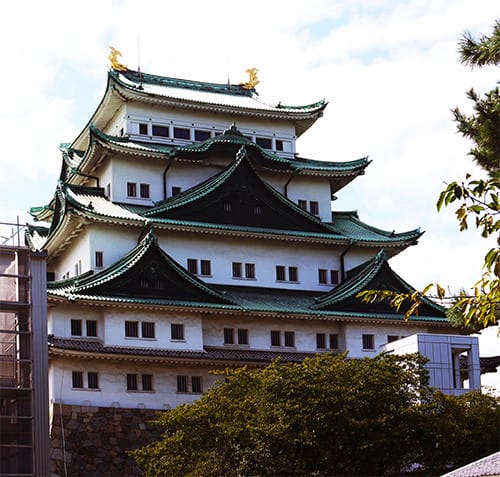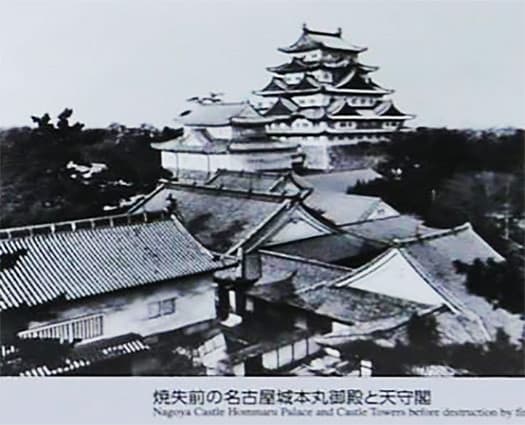

城郭は広い意味では「住宅の分類」という説に導かれて探訪記、今回は名古屋城。「尾張名古屋は城で持つ」という天下の名城であります。建築関係の探訪記録がわたしのMacには大量に保存されていて、こちらの記録は2015年9月のフォルダに入っておりました。調べてみると、この時期に新住協の全国大会が名古屋で開かれているので、そのときに時間を縫って、撮影したものと思われます。わたしの仕事人生では住宅についての技術革新の動きが並行して進行していた。北海道由来の技術が本州各地域に拡散していった時期と重なっているのですね。
で、わたしは小学校低学年時代から、とにかく戦国期・源平期の日本史にどっぷりと脳内占拠されて過ごしていた。信長・秀吉・家康の3英傑を輩出した名古屋地域には、その地名を聞いただけでも「血湧き肉躍る」感覚がさわがしくなってしまう。ということで、尾張名古屋は城で持つ、という名古屋城探訪篇であります。
上の写真は、名古屋城の天守閣から尾張平野を見晴らしたショットと、本丸天守の外観。当時は修復工事のまっ盛りだったようで、工事のフェンスなども見られていました。

名古屋城は徳川幕府体制が確立してその体制のひとつの存続装置として「御三家」という将軍輩出システムが家康によって創出されて、かれの九男・義直を初代としてされた尾張徳川家の本城として、1609年に家康自ら築城を決定した。翌年から石垣などの大土木工事に着手して、1612年に店主や各櫓が完成した。・・・ということなので、わたしの少年期からの素志である信長が絡んでいるという城ではない。そういう残念感があり続けていた。日本史を縦横に切り裂いた「革命家」の極地である人物の残影からは縁遠い城郭ではある。
しかし、この尾張徳川家創建に至る歴史の波瀾万丈は、この名古屋城にも違う意味では投影されているとは言えるでしょう。尾張地域というのは、記紀の時代でも重要な地域権力として日本史に大きく影響を与えた存在だったことを考えれば、どうしてこの地がそういう日本史のカギを握っていたのか、ということがわかってくるのでしょう。
そういえば、わたしの人生での職業選択でもこの地域に深く絡んでいた広告会社に入社し、そしてはるかな身近では、わたしの家2.0の隣地には名古屋が本拠の大企業があって、そことの「取引」によって境界線変更に立ち至った。この会社は、先述の広告会社のクライアントだったので、はるかにその企業名は知り及んでいた。「え、◎◎会社さんがお隣なんだ・・・」と。
さてそういう尾張名古屋城、謹んで探訪させていただきたい。
English version⬇
The Castle that “holds” Owari-Nagoya: Exploring Nagoya Castle-1
Owari-Nagoya is an area that I was involved in at various points in my life. However, I have not had the opportunity to visit the area in person that often. I would like to relive it in this exploration of a famous castle under heaven. ......
This time we will visit Nagoya Castle, guided by the theory that castles are, in a broad sense, a “classification of houses. This time, I visited Nagoya Castle, which is a famous castle under the name of “Owari-Nagoya is held by its castle”. I have a large number of records of architectural visits saved on my Mac, and this record was in the folder for September 2015. I found out that the national convention of Shinjyukyo was held in Nagoya around this time, so I must have taken these photos during that time. In my professional life, there was a parallel technological innovation movement going on regarding housing. It coincided with the diffusion of technology originating in Hokkaido to the various regions of Honshu.
Since my early elementary school days, my brain had been occupied with Japanese history of the Warring States and Gempei periods. The Nagoya area, which produced three heroes, Nobunaga, Hideyoshi, and Ieyasu, arouses my “blood-rushing” sensation even at the mere mention of the name of the place. This is an exploration of Nagoya Castle, where Owari-Nagoya is said to have a castle.
The photo above is a view of the Owari Plain from the castle tower and the exterior of the castle tower. The castle was in the midst of restoration work at the time, and the construction fence was visible.
Ieyasu decided to build Nagoya Castle in 1609 as the main castle of the Owari Tokugawa family, which was headed by his ninth son, Yoshinao, after the establishment of the Tokugawa shogunate and the creation of the “Gosanke” system of producing shoguns as a means of maintaining the shogunate. In 1609, Ieyasu himself decided to build the castle as the main castle of the Owari Tokugawa family. The following year, he started major civil engineering work including stonewalls, and in 1612, the storehouse and various turrets were completed. The castle was not built with the involvement of Nobunaga, who had been a great admirer of mine since I was a boy. I continued to have such a sense of disappointment. It is a castle that is far removed from the shadow of the man who was the ultimate “revolutionary” who tore through the length and breadth of Japanese history.
However, it can be said that the vicissitudes of history that led to the founding of the Owari Tokugawa family are also projected onto this Nagoya Castle in a different way. Considering that the Owari region was an important regional power that greatly influenced Japanese history even in the Kiki period, one can understand why this region held such a key to Japanese history.
Come to think of it, my career choice in life was to join an advertising company that was also deeply involved in this area, and much closer to home, there is a large Nagoya-based company located next to my house 2.0, which led to a boundary change through a “deal” with the company. This company was a client of the aforementioned advertising company, so I knew the name of the company by heart. I was surprised to learn that this company was a client of the aforementioned advertising company, so I knew the name of the company for a long time.
Now, I would like to visit Owari Nagoya Castle.




























※コメント投稿者のブログIDはブログ作成者のみに通知されます